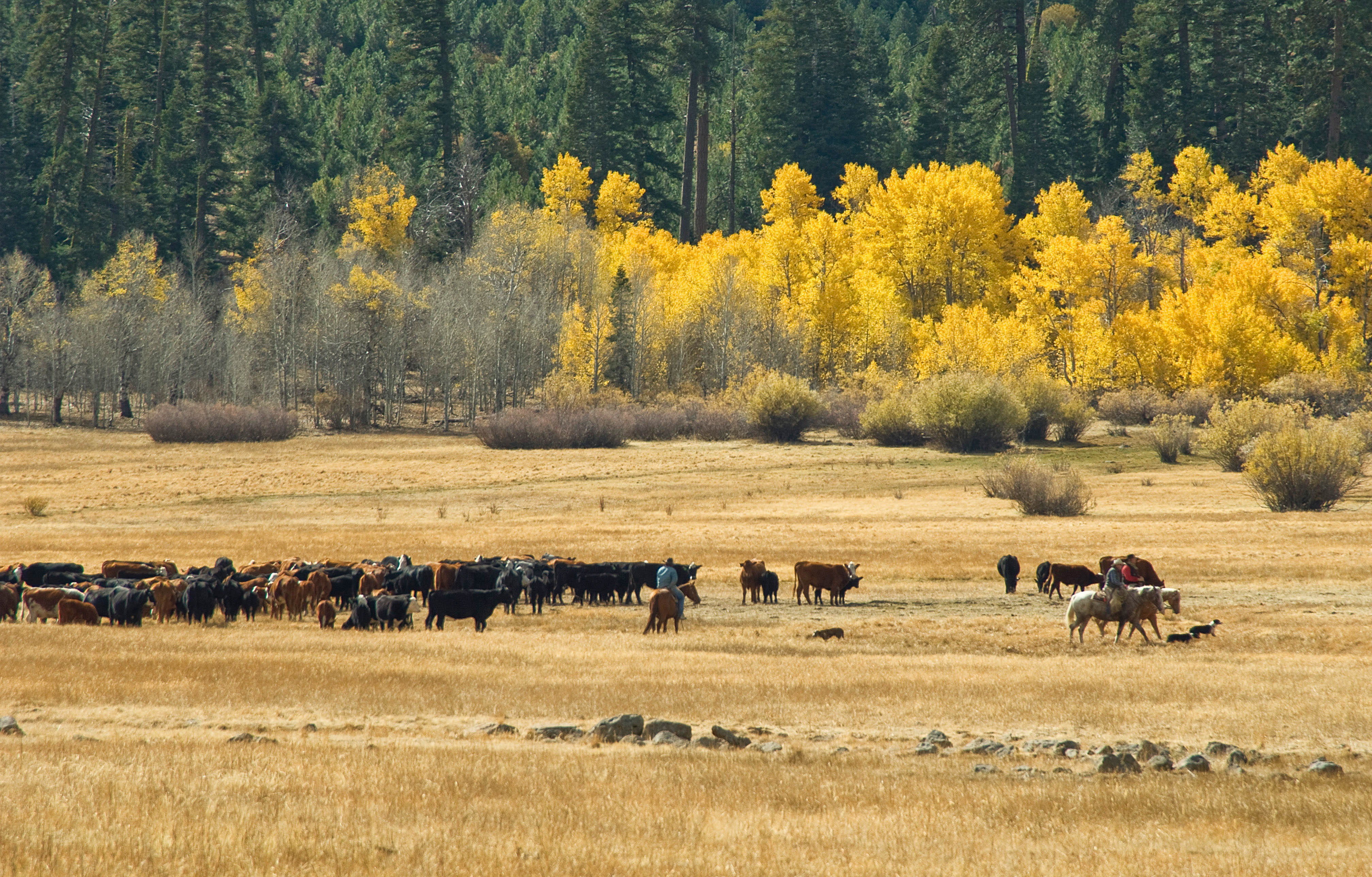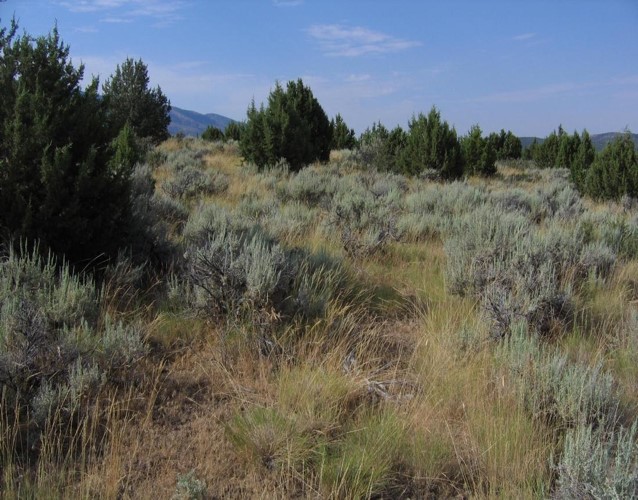Sensitivities
A. There will be increased opportunity for invasive species establishment with increased disturbance and shifting plant species composition under changing climate.
B. Climate change may lead to loss of climatically suitable habitat for persistent pinyon-juniper ecosystems.
C. Many sagebrush ecosystems are in poor ecological condition because of past overgrazing, invasives, and other factors; climate change may increase stress on these ecosystems by shifting species composition, providing opportunities for invasive species establishment, and allowing for emergence of new invasive species.
D. Conifers are likely to continue expanding into sagebrush and grassland ecosystems under changing climate.
E. Drought increases the amount of bare ground in rangelands, increasing potential for wind and water erosion.
A. Sensitivity: There will be increased opportunity for invasive species establishment with increased disturbance and shifting plant species composition under changing climate.
Explanation
Rapid removal of vegetation following wildfire will create open space and light that facilitate regeneration of both native and nonnative species, creating the potential for long-term change in species distribution and abundance (Hellmann et al. 2008).
Practices
Increase invasive species control and prevention efforts
- Inventory regularly to detect new populations and species; map new and existing infestations of invasive weeds
- Implement early detection/rapid response for invasive species treatment
- Include invasive species prevention strategies in all projects
- Expand promotion of weed-free seed especially in non-wilderness areas
- Educate employees and the public about invasive species and their detrimental effects on ecosystems
- Coordinate invasive species management, funding, and support among agencies
Maintain or restore ecological integrity of native rangeland ecosystems to prevent spread of invasive species
- Apply ecologically-based invasive plant management (EBIPM) principles
- Identify areas more susceptible to wind erosion post-fire, and pre-plan activities to reduce wind erosion risks
- Increase resilience of native species where intact or productive communities exist
- Treat invasive species with appropriate management practices or biotic-path herbicides
- Monitor soil stability and productivity to reduce low-fertility soils that promote invasives
- Identify and promote early-successional natives that may be able to compete with invasives (e.g., seeding of native plant species)
- Reduce grazing practices that encourage spread of non-native species
- Periodically reevaluate sustainable animal unit months (AUM) and appropriate management levels (AML) to account for changes in rangeland productivity as annual and seasonal temperatures increase
B. Sensitivity: Climate change may lead to loss of climatically suitable habitat for persistent pinyon-juniper ecosystems.
Explanation
Prolonged droughts, which will be more common in a warmer climate, can stress low-elevation pinyon pine, leading to mortality from beetles in some locations (Clark et al. 2016).
Practices
Maintain and restore ecological integrity of persistent pinyon-juniper communities.
- Identify and map persistent pinyon-juniper communities and assess current conditions
- Reduce invasive species; maintain or restore native understory composition
- Maintain or restore structural diversity to promote natural disturbance regimes
- Reduce stand density where appropriate
- Actively protect high-value trees and stands from beetles, if necessary
C. Sensitivity: Many sagebrush ecosystems are in poor ecological condition because of past overgrazing, invasives, and other factors; climate change may increase stress on these ecosystems by shifting species composition, providing opportunities for invasive species establishment, and allowing for emergence of new invasive species.
Explanation
Increasing frequency of prolonged droughts in a warmer climate can increase stress in sagebrush and other native shrubs, killing them or reducing canopy cover, making it easier for some nonnative species (e.g., cheatgrass) to become established (Finch et al. 2016).
Practices
Improve resilience and resistance of sagebrush-grass ecosystems to changing climatic conditions
- Maintain vigorous growth of native shrub, grass, and forb species
- Develop a flexible grazing management plan
- Adapt grazing management practices and policies to improve ecological resilience and resistance
- Monitor successional patterns and long-term effects of fire on sagebrush ecosystems to inform management actions
- Control invasive species affecting the ecology of sagebrush ecosystems
- Actively manage conifer encroachment to maintain sagebrush ecosystems
- Utilize native seed sources for restoration (planting) that will be adapted to future climate conditions
- Develop seed zones and promote propagation of native seed sources for sagebrush ecosystems
- Protect existing sagebrush communities from high-intensity wildfire (but consider prescribed fire)
- Protect locations where invasive species are absent
Manage for soil conditions to avoid increased runoff
- Protect and promote cryptobiotic soil crust
D. Sensitivity: Conifers are likely to continue expanding into sagebrush and grassland ecosystems under changing climate.
Explanation
With warming, juniper encroachment is expected to increase at higher elevations that are currently too cold (Weisberg et al. 2007). Juniper encroachment will be favored where climate change increases winter precipitation and reduces summer precipitation (Miller and Rose 1999).
Practices
Control expansion of juniper
- Identify current and future critical areas to optimize the benefits of control measures
- Prioritize Phase I and Phase II juniper (lower juniper density), and Phase III juniper (high juniper density) where deep soils have allowed retention of native grasses
- Use mechanical control
- Use prescribed fire and managed wildfire to kill younger trees
E. Sensitivity: Drought increases the amount of bare ground in rangelands, increasing potential for wind and water erosion.
Explanation
Increased frequency of prolonged drought in a warmer climate will weaken and kill some plant species, thus reducing plant cover and exposing bare ground. This can promote establishment and production of nonnative species (Finch et al. 2016).
Practices
Increase or maintain ground cover with drought
- Manage the amount, timing, and distribution of domestic ungulate herbivory and removal of plant cover and impacts on cryptobiotic soil crust; develop proactive, flexible, and adaptive allotment management plans
- Consider utilization of forage in allotments by native ungulates and adapt authorized AUMs accordingly
- Provide rest or defer grazing on lands in an unhealthy condition
- Reduce or eliminate conifer encroachment and reduce sagebrush density to no more than 25% in warm-dry sagebrush and no more than 30% in cool-moist sagebrush to maintain native herbaceous cover and composition
- Reseed after disturbance with drought-resistant native plants
- Promote healthy soil and biodiversity (both above and belowground) to increase drought resilience (e.g., increase organic matter to increase soil water holding capacity and improve retention and recovery of cryptobiotic soil crust)
- Better manage wild horse and burro populations to reduce impacts during drought and promote vegetation recovery after drought; include population reduction or elimination and exclusion among the management options
Increase communication, education, and collaboration with range users and public users during drought
- Clearly define thresholds that will trigger alternative management strategies
- Ensure ongoing collaboration focused on drought conditions and possible mitigation
- Implement local stewardship programs that include multiple participants
- Ensure that employees are familiar with and sensitive to local ranch and range culture
Develop integrated drought management plans for allotments and base properties with willing permittees and leasees
Introduction Hydrology, Water Uses, and Infrastructure Forest Vegetation Non-Forest Vegetation
Riparian Areas, Wetlands, and Groundwater-Dependent Ecosystems Fish Habitat and Fisheries Wildlife Recreation References
Climate Risk Management Practices prepared by: J.J. Ho; J.E. Halofsky; D.L. Peterson

